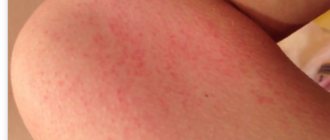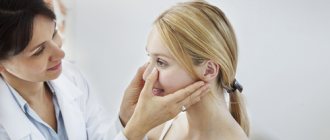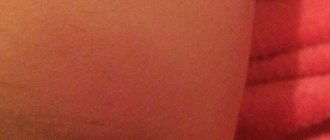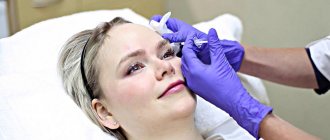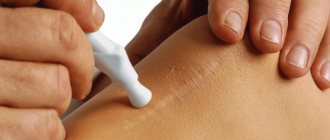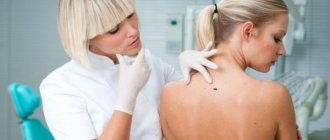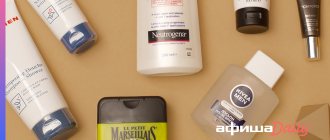How to make a preliminary diagnosis yourself
The photo shows a blockage of the sebaceous duct
If a lump appears under the eyebrow, then it can be either a banal pimple near the eyebrow, which does not require surgical intervention, or a very serious tumor that requires prompt professional medical intervention.
Removal using modern methods, quickly and safely
There is no pain when pressed, the skin is not reddened.
Important. Be sure to get an x-ray and be examined by a specialist.
Self-diagnosis and treatment delay the correct identification of the disease and may miss the opportunity for quick and effective treatment in the early stages.
Symptoms and causes of some tumors
We do not delay treatment
Let's look at the most common causes and treatment options if a lump appears above the eyebrow in an adult. In any case, be sure to consult a doctor to rule out more serious diseases than those discussed below.
Wen or lipoma
Squeezing out lumps without a diagnosis is simply dangerous
Many people call any tumors wen and try to treat them with traditional methods of the last century. A lipoma is formed from adipose tissue.
Why does it appear:
- disruption of the endocrine system and disruption of protein metabolism. The regeneration and metabolism of skin cells are impaired, so adipose tissue is formed faster;
- heredity plays an important role. This is why lipomas can appear at an early age and during puberty;
- Failure of the hormonal system can also provoke wen;
- diabetes mellitus and atherosclerosis of blood vessels also cause these formations on the face and body.
This removal leaves no scars on the face
- a lump under the eyebrow can appear with chronic diseases of the stomach and intestines, as well as problems with the liver and kidneys;
- a love of sweets and a lack of vitamin E, plus a love of strong alcoholic drinks is a direct path to the formation of fatty tissue;
- oily skin is the biggest risk, since blockage of the sebaceous glands is most often observed with poor and irregular care for problem skin, especially during puberty.
Important. The nature of the appearance of such formations has not been fully studied even now, and the reasons for their appearance can be the most unpredictable.
This mainly applies to large tumors, the growth of which has not yet been explained by science.
Drug injections
The types of lipoma are also varied:
- Milium is a white tumor that occurs due to improper self-squeezing of acne and skin injuries. Caused by blockage of the sebaceous gland. Cosmetology instructions recommend mechanical removal.
- Xanthoma is many small tumors merging into one. They have a wide variety of shapes. May be yellowish in color. They are completely painless and move under the skin when pressed. It has been noticed that such formations appear in women during menopause with a surge in hormonal activity.
Important. These formations do not degenerate into dangerous malignant tumors.
You can remove them with your own hands, but only after thoroughly disinfecting the instruments (needle) and skin.
Section view of the tumor
Treatment can also be medication for small tumors. In cosmetology clinics, the doctor punctures the lump and injects medicine. The most commonly used is Diprospan. Within a few months, the lump resolves. (See also the article What to do if your eyebrow twitches.)
Modern methods offered by cosmetology centers:
- surgical removal and suturing (may leave scars on the face);
- deep facial cleansing (glycolic, retinoic);
- laser beam grinding is the most effective removal technique, but the price is rather high;
- complex physiotherapy.
Advice. The problem must be treated comprehensively, identifying the cause of the appearance of the bumps.
Additional intake of complex vitamin and mineral preparations helps.
Causes and symptoms of bruises
The main causes of facial bruises: a fall from a height, a blow from a hard object, compression of facial tissue during road accidents or natural disasters.
The first sign of a facial injury is pain. This is a signal of damage or irritation of nerve fibers. The intensity of pain depends on the severity of the injury and the location of the affected area.
The most lasting pain occurs when the nerve trunks of the face are damaged. In this case, the injured person experiences sharp, burning and shooting pain. It intensifies with any movement of the facial muscles.
After exposure to a traumatic agent, the skin acquires a bright red tint. This is how the blood entering the interstitial space shines through the skin. Gradually its concentration increases, and the affected area changes color to blue-purple.
Gradually, the breakdown of hemoglobin begins in the hematoma. After 3-4 days, a breakdown product of blood cells, hemosiderin, is formed, which causes a green color, and on days 5-6 hematoidin, which is yellow in color.
This alternating change in the color of the hematoma is popularly called “blooming bruise.” In the absence of complications, the hematoma completely resolves within 14-16 days.
Reasons to immediately consult a doctor are the appearance of clear fluid from the ear, cyanosis (blue discoloration) of the area around the eyes, convulsions, loss of consciousness, nausea and vomiting. These are signs of a serious traumatic brain injury, requiring a detailed examination of the body and certain treatment tactics.
In traumatology, bruises are classified according to severity. This allows you to determine treatment tactics and assess the possible risk of complications.
Bruises are characterized by minor damage to the subcutaneous fat. They do not cause concern, do not require contact with a specialist and resolve on their own within 5 days. There may be minor pain and blue discoloration of the damaged area.
Severe damage to subcutaneous fat. Bruises are accompanied by hematoma, swelling and acute pain. In this case, complex treatment with pharmacological drugs is necessary.
A severe bruise affecting the muscles and periosteum is often accompanied by a violation of the integrity of the skin. There is a high risk of bacterial infection. In these cases, a visit to a traumatologist is mandatory.
Rated as extremely severe. In this case, the functionality of the facial skeleton is impaired and the risk of complications from the brain is high. The condition of the injured person requires emergency medical attention.
Folk and medicinal external remedies for lipoma
If a lump appears on your eyebrow, you can try to remove it using the following medications:
- Videstim ointment and Gistan cream have an anti-inflammatory effect. The active substance - retinol promotes the resorption of adipose tissue;
- celandine - helps against small wen. Apply directly to the bump and leave for half an hour. Be careful, the drug may burn the skin. Therefore, after such applications, I recommend applying Vishnevsky ointment, which relieves inflammation;
- aloe juice - apply as a compress. The pulp from the leaf is more effective;
- onion - bake one onion, mix with honey, preferably linden, add one teaspoon of laundry soap. Lubricate twice a day. Store the ointment in the refrigerator;
- Grind sunflower oil and one clove of garlic and apply to the pine cone for a month;
- melted mutton fat also helps in treating such bumps.
Important. The use of traditional methods if a lump appears above the eyebrow is possible, but only after the doctor makes a diagnosis.
Otherwise, you may miss the development of serious diseases.
Removal without consequences
Self-medication leads to irreversible consequences; it is important to correctly diagnose any formation. The video presented in this article will tell you about bumps of different etiologies in detail and clearly. If you have any questions or comments about the article, ask them in the comments.
Some tips for treatment
- To treat swelling on the face, use a number of ointments of pharmaceutical origin: first of all, this is Troxevasin. It will not only help relieve swelling, but also promote the resorption of hematomas. It is possible to use Heparin ointment.
- It should be remembered that most pharmaceutical ointments are designed to relieve not swelling, but a hematoma (bruise) and are of little help in treating swelling.
- Cabbage leaf with honey is good for relieving swelling. You can put the cabbage through a blender (or grate it) and mix it in a 1:1 ratio with honey. Then apply the paste as a compress for 1.5–2 hours.
- Often, grated raw potatoes are used to relieve swelling. Or even circles as a compress. The duration of the compress is from 0.5 hours to 40 minutes.
- Do not apply heat. This will only increase the swelling; warm compresses are also not necessary.
- Do not use Bodyaga powder. It dries the skin on the face, and especially under the eyes, this will cause additional problems. Use it to treat bruises in other areas.
- Do not massage the swelling. Here, the integrity of the blood vessels is already compromised, and with the help of massage you will only increase subcutaneous bleeding and contribute to the formation of a hematoma.
All people, regardless of age, are susceptible to facial bruises. A relatively simple injury may conceal serious damage to the deep layers of facial tissue and bones of the facial skeleton, which can lead to complications.
Correctly provided first aid, timely consultation with doctors and adequate treatment tactics will help to avoid complications and aesthetic discomfort.
A lump on the forehead is a hematoma, when blood vessels are injured, ruptured and blood accumulates in the resulting space. A bruise after a blow after some time acquires a bluish, and sometimes with a purple tint.
Typically, such injuries do not require medical attention. Over time, they will go away on their own or you can speed up the recovery process with the help of special means, both medicinal and folk.
In rare cases, self-treatment of a lump is prohibited.
- inability to turn your head;
- nausea;
- vomit;
- enlarged pupils;
- blurred vision;
- severe pain in the forehead;
- retardation of movements;
- confusion;
- pale skin, blue lips;
- convulsions.
These signs indicate a concussion and require urgent medical advice.
Before use, soak the bag in water to soften the tissue, and apply a compress, aligning it closely with the bump. Change the compress approximately every three minutes; spare pieces of cloth dipped in ice water should be on hand.
The duration of the cold procedure is from ten minutes to an hour. Only in this case will the bump go away after the blow.
The next day, grind the cabbage leaves through a meat grinder, boil lightly in milk, place on a napkin and apply a warm compress to the bump. Such folk remedies always help.
The procedure lasts an hour, after which the cone should be washed with water. Warm compresses will relieve swelling and promote the resorption of the lump.
Heated salt, an egg, and special heating devices (lamp) are suitable for this.
Thyme, also known as thyme, has a healing effect. Fresh thyme leaves applied to the bruise should promote healing.
You can try to prevent the bump from appearing after the blow. Soak a cotton pad or gauze folded in several layers generously with vegetable oil. Apply the lotion to the site of the impact and keep it there for at least half an hour.
Mix half a glass of alcohol (960) and half a glass of iodine and lubricate the lump with the resulting preparation in the morning and evening.
Severe headaches and dizziness require immediate medical attention.
Use wormwood. Grind the fresh grass and lubricate the bruised area with the collected juice.
Turn into powder and mix dried daisy flowers and oak bark, brew a tablespoon of the mixture with a glass of boiling water, wait half an hour, moisten a rag with this infusion and apply to the injury site.
Make a compress from raw potatoes, grate them on a fine grater and wrap them in cloth. Repeat in the morning and evening for 20-30 minutes.
Light massage
The desire to rub the injured area is a common reflexive reaction to a bruise. This must be done immediately, immediately after you hit yourself. Later it is useless and even unsafe.
Rub the injured area vigorously, but without strong pressure. In this way, you will be able to relieve spasm from a significant part of the vessels and protect them from rupture under the pressure of the incoming blood flow.
The rubbing procedure should last no more than one minute. In addition, rubbing ensures the outflow of “waste” lymph and blood, the renewal of these physiological fluids, which contributes to the speedy restoration of the damaged area.
Rubbing the injured area is similar in effect to instant anesthesia. The pain noticeably dulls or goes away completely.
Cold compress
After the functionality of some of the vessels and blood circulation have been largely restored, the bruised area will require a cold compress. Its action is diametrically opposed to rubbing.
A cold compress is necessary to prevent bleeding through ruptured vessels. Under the influence of cold, they shrink and become clogged, thereby preventing the formation of a tumor in the form of a lump on the head.
To prevent the formation of a hematoma, it is best to apply ice cubes, previously placed in a plastic bag and wrapped in cloth, to the bruised area. If they are not there, then anything with a negative or low temperature will do.
But in any case, in order to prevent hypothermia of the bruised area, the procedure using them should not exceed several minutes.
If, in case of a bruise, you immediately provide first aid to the patient, then the next day there will be no trace of the bump.
- Carefully treat the impact site with hydrogen peroxide (or Chlogexidine, Miramistin), especially if, in addition to the bump, there is a bleeding wound.
- Apply a cold object to the sore spot. This could be: a cold towel, a bottle of ice water, a large silver spoon. You can take a piece of frozen meat or fish out of the freezer, but before applying it to your forehead, be sure to wrap it in a clean cloth.
It is important to provide first aid if a bump appears on the forehead from a blow.
Follow the steps below correctly and in a timely manner, this will help remove the bump on your forehead in 1 day.
- Inspect the site of damage, notice a wound, abrasion, treat it with a disinfectant (Hydrogen Peroxide, Chlorhexidine, Miramistin); - Apply a cold compress to the site of impact: a metal object (spoon, coin), a bottle of water, a cloth soaked in cold water, ice wrapped in gauze. You need to hold it for 10-15 minutes to quickly get rid of the bump caused by the blow.
The use of a bandage should be combined with cold therapy. With a compression bandage, there is no longer any need to wrap ice cubes and other things in cloth. It is enough to place them in a plastic bag and periodically change them as they heat up to maintain the desired temperature of the injured area.
Here we will talk about compositions and products, the action of which, as in the case of traditional ointments and gels, is aimed at increasing blood circulation and removing thickened blood residues from the site of hematoma formation, in other words, relieving swelling. Among the non-traditional methods of treating a bump on the head after a blow, there are a dozen of the most effective ones.
We suggest you read How to make a honey face mask
Aloe. The leaf is cut lengthwise and kneaded until abundant juice is released. Next, the crushed sheet is applied to the cone, covered with polyethylene and a piece of clean rag folded several times. The compress is applied at night each time with a fresh aloe leaf. The lump goes away within two to three days.
Mustard powder, salt, honey. The listed ingredients are mixed in equal quantities. The resulting ointment is applied to a piece of gauze folded several times, applied to the hematoma, and fixed with an adhesive plaster. It is better to apply the compress at night. In the morning, its remnants are washed off, and the injured area is treated with iodine or medical alcohol.
Most often, children suffer from lumps on the forehead. Hitting hard against a corner, closet or sofa is a favorite pastime for little fidgets. But sometimes an adult runs into some kind of joint and breaks his forehead.
First, determine by its appearance and the degree of impact produced how dangerous the lump is to health. From a medical point of view, a bump on the forehead from a blow is an ordinary hematoma, accompanied by bruising, i.e. bruise
When you hit a hard object under the skin, tissue, large and small capillaries rupture, and a cavity is formed in which blood and lymph accumulate.
After a strong fall, after a while, literally before our eyes, the site of the impact swells and swells. Bursting small subcutaneous capillaries are visible through the skin, and the injured area turns blue - a bruise appears. A hard, painful “pillow” or ball is palpated in the center of the bruise - this is a hematoma.
Dermoid cyst on the brow ridge in a child
Went to see the light
- 79 messages
- Country Russia
My baby is 9 months old. a lump appeared above the eyebrow under the skin. We went to the surgeon - she touched it, crushed it - the lump has a leg. They did an ultrasound and in the end they said it was a dermoid cyst (the so-called wen). You can only delete them from the age of 3. not before and under general anesthesia - it became SCARY. They told me to watch for a year. trace the boundaries of the bump on tracing paper and watch how it grows. For the time being I did not grow. But a month ago I noticed that she had completely disappeared - my joy knew no bounds. Then his temperature rose to 38-39, although he had no cold (no snot, no throat, no cough - nothing), then diarrhea began for 5 days. The doctor said that it was the intestinal flu that he had. We identified the diarrhea and I see the lump is starting to grow again. Only it is no longer small - it was 1 cm in diameter before, but somewhere around 1.8 - 2 cm with unclear boundaries - the eyebrow is simply swollen. We made an appointment again for a consultation. And yesterday he fell out of my chair right on this side where the lump is. In short, it’s a bruise, it’s all gone. I'm afraid it will get even worse. The surgeon said she couldn’t say anything until the swelling from the bruise went away, she prescribed trocrerutin and that’s it. I’m already tormented by the thought of what if something was not good and the blow caused even more damage. I didn't sleep all night.
Dad is with the baby today, I called. He says there is a black eye and a scratch under his eye. The swelling subsided, but the lump remained.
Lump under the skin on the forehead
A ball or lump under the skin on the forehead under the skin can mean anything. This includes a serious health condition such as cancer, a bone spur (osteoma), or just a sinus infection (sinusitis). Various bumps may appear between or above the eyebrows.
A subcutaneous formation that appears on the forehead usually does not cause any complications, and most of them go away without any medical help. A common cause of this problem is a sebaceous cyst. This is a tumor on the skin that occurs due to inflammation of the sebaceous glands. These bumps form when pores become blocked and fill with sebum and other dead cells.
Treatment for lumps under the skin always depends on the cause. For mild cases, ointments can be used. In other cases, they will quickly go away on their own. You should consult a doctor if itching occurs, the lump does not go away for a long time or begins to spread to other parts of the body.
Atheroma (sebaceous cyst)
This is the most common cause of forehead balls or bumps. Cysts form on the sebaceous glands after they become clogged with yellowish sebum. They can go away on their own without medical help.
The cyst is not malignant and contagious. Atheromas grow slowly and are not life-threatening. Over time, they can become uncomfortable if their growth is not stopped. It is necessary to visit a doctor to make sure that the lump is not cancerous.
Treatment usually involves preventing severe symptoms and reducing the likelihood of future recurrences. The doctor may use a syringe to drain the atheroma or perform a surgical procedure. Topical and steroid medications may be used.
Osteomas develop from bone tissue. They may occur at birth or develop over time.
The cause is unknown, but it is believed to be an inherited condition.
Osteoma is not a health problem, and the lump may go away on its own in less than a year. Therefore, the treatment is only given to those who have cosmetic concerns. A surgical procedure may be recommended to remove the tumor.
Treatment of osteoma
Osteoma forms when new bone grows on existing bone. The condition is common in children and young adults, but is rare in older people. Osteoma is a benign tumor, not cancerous, does not spread to other parts of the body and can go away on its own. Therefore, treatment does not involve removing the tumor, but reducing pain, which is its most common symptom.
The following treatment can be carried out:
- Treat pain and allow swelling to go away on its own
- Perform surgery to remove it
- Use radiofrequency ablation (RFA).
Lipoma (wen) is a harmless fatty deposit under the skin. They are mild and most are painless. They are also easy to diagnose compared to other skin conditions. Lipomas are not harmful, but a dermatologist can remove them if necessary.
People of any age are susceptible to this problem. It is classified as a benign tumor and is not contagious. The following are the characteristic features of lipoma:
- It is soft and movable when touched
- Grows slowly and does not spread to other parts
- Manifests itself in the form of bumps on the forehead (although it can generally form on any part of the body)
- Located under the skin
- They appear pale compared to the surrounding skin.
A biopsy is performed to diagnose the condition. In mild cases, such a formation does not pose any health risks or complications and therefore does not require treatment. However, if symptoms are bothersome, your doctor may prescribe one or more of the following treatment options:
- Surgical procedure
- Steroid injection for inflammation, both in joints and soft tissues
- Liposuction, in which a syringe is used to remove the fat forming the lipoma through suction
- Ointment for pain, itching and swelling
Cancer refers to the formation of malignant tissue that begins to attack and damage neighboring cells. A common symptom is a painless swelling on the face. Cancer is a chronic disease. If you notice the following symptoms, you should seek medical help immediately:
- Painless lump on forehead
- A bump-like birthmark called melanoma
- Red dry bump
- A red, thick spot that may bleed frequently
- The spots increase in size
- Uneven spot.
The earlier cancer is diagnosed, the higher the chances of curing it. Depending on the type and severity, the doctor may prescribe chemical, radiation therapy or surgery to remove the formation.
Acne is a small, painful, red or pink bump on the forehead. They can appear as individual pimples or form groups. They form when skin pores become blocked and fill with dead cells and sebum. The resulting lumps can lead to acne or pimples.
The condition can be mild or severe. In the first case, a simple warm compress and aloe vera will help get rid of pimples and reduce the annoying urge to scratch them. On the other hand, severe acne can be treated with acne medications and antibiotics to reduce the chance of infection.
You should consult a doctor if symptoms persist or the pain and itching become unbearable.
Angioedema
Another possible cause of forehead lumps is angioedema, also known as angioedema, which involves swelling, itching, pain and burning. It can be caused by an allergic reaction to chemicals in food, insects, and medications that cause the body to release histamine.
Histamine in the body causes blood plasma to leak from the vessels into the skin, causing hives or angioedema. It may also be caused by a genetic disorder that may be inherited from parents.
Other reasons include;
- Pregnancy
- Anxiety or stress
- Extreme hot or cold temperature.
Treatment for angioedema will depend on its type and cause. However, common treatment options include:
- Avoid allergic triggers
- Antihistamines and steroids
- Automatic adrenaline injection for specific allergies.
For hereditary conditions, medications will be used to prevent and treat swelling.
Allergic reaction
An allergic reaction is a common cause of skin rashes and bumps. Lumps are usually accompanied by redness and swelling of the skin. An example of an allergic skin condition is allergic eczema.
Allergic eczema is a skin reaction that causes an itchy red skin rash. The rash may consist of raised red bumps that may ooze.
Avoiding the allergy-causing substance is fundamental to preventing a reaction. An example is maintaining a gluten-free diet for those with allergies to gluten, contact with animal dander, etc. Anti-itch and anti-swelling creams can be used for mild cases of rashes.
The mechanism of swelling due to bruise
To effectively remove swelling on the face from a blow, first of all, you should understand how the process of its formation itself takes place.
Thus, from sharp compression of tissues at the site of impact or sharp pressure, the integrity of tissues and small blood vessels is damaged. At the same time, the skin is stronger, it is usually intact, but under it, fragile vessels burst from compression, and fluid is released from the tissues. These two factors provoke the appearance of swelling. In this case, at first the swelling is soft and in many cases quickly increases in size, and then after 8–10 hours a hematoma begins to appear. The blood under the skin hardens, the skin first turns purple, gradually turning into dark blue and then purple.
If the blow was strong, the swelling will not go away for several days. And the purple spot will increase in size for about three days and only then will begin to lose its color and go away.
The appearance of swelling is an alarming signal and requires immediate action. They can significantly reduce the risk of large swelling and bruising.
So, all activities can be divided into several stages:
- urgent and immediate assistance immediately after the impact;
- consultation with a doctor is required if nausea, dizziness, or redness of the eye occur;
- treatment of edema and hematoma.
It is very important to apply cold to the impact site immediately after the incident. Usually everyone advises to apply ice, but it is important to do this as quickly as possible, so it is not necessary to look for ice. You can use any cold object that is close, for example, a metal spoon. And then look for a more permanent source of cold.
Be sure to keep it cold for at least 1 hour. A short time will not allow the burst vessels to thrombose, and the blood will flow further, which will cause an increase in swelling and hematoma.
A lump has appeared above the eyebrow - what is it? - treatment
Any formations on or under the skin are cause for concern and require detailed examination. And when something like this occurs on the face, there is also aesthetic discomfort, forcing one to look for the cause and ways to solve the problem. The appearance of “bumps” in the forehead, bridge of the nose and eyebrows is often noted, which attract attention and become a signal to contact a specialist.
Causes and mechanisms
A lump on the eyebrow can form for various reasons. A seal in the skin is formed as a result of an inflammatory process, an allergic reaction, mechanical damage or tissue proliferation. And any of the mechanisms entails structural changes that are difficult to miss.
Therefore, when identifying a lump on the forehead or near the eye in an adult or child, a number of pathological processes must be excluded. In addition to common acne, the causes may be:
- Furuncle.
- Lipoma.
- Atheroma.
- Consequence of injury.
- A bite of an insect.
- Malignant tumor.
As you can see, the range of possible conditions is quite extensive, it also includes dangerous conditions that it would not hurt to know about. It is necessary to understand that any formation on the skin that has not previously existed requires examination with the participation of a doctor.
The origin of the lump on the bridge of the nose can be different, so when the first symptoms appear, you should contact a specialist for appropriate diagnosis.
Symptoms
To determine the cause of the swelling, you will need to be examined by a doctor. For this, the specialist needs anamnestic information (complaints and development of pathology), examination data and physical methods (palpation). Based on the above, a preliminary diagnosis is formed.
Consequence of injury
In children and adults, the cause of a lump on the forehead above the eyebrows can be bruises. With a closed mechanical injury, tissue damage develops, which is aseptic (non-infectious) in nature. However, the signs will often be similar to inflammatory ones:
- Edema.
- Redness of the skin.
- Soreness.
Injury can be assumed based on the history (fact of injury), identification of abrasions, bruises or hematoma. The accumulation of blood in the tissues leads to a change in skin color: from bluish-burgundy to greenish-yellow. If the injury was more severe, the patient experiences additional symptoms:
- Headache.
- Dizziness.
- Noise in ears.
In such cases, it is necessary to exclude a concussion or a violation of the integrity of bone structures (fracture). But the doctor will always understand what you have to deal with.
Swelling in the eye and forehead area can form due to a blow or other mechanical damage. But we must not forget that the consequences of some injuries can be quite serious.
Insect bites
The skin above the eyebrows in children may swell due to insect bites (most often mosquitoes). In such a case, noticeable itching occurs, local redness forms, and with strong scratching, abrasions are visible. Microbes sometimes penetrate through damage to the epidermis, which gives rise to pyoderma.
Malignant tumor
Perhaps the most dangerous condition characterized by tissue swelling is a malignant tumor. Pathological cells can have different sources: epithelium (cancer) or connective tissue, including muscle and bone (sarcoma).
The tumor may look like a small ball or swelling without clear boundaries, but the malignant process will certainly begin to destroy tissue and metastasize over time.
Therefore, in the clinical picture, in addition to local signs (skin defect, enlargement of local lymph nodes), there will also be general ones:
- Weakness and fatigue.
- Pallor.
- Decreased appetite.
- Weight loss, etc.
In order to detect a malignant tumor in a timely manner, it is necessary to exercise oncological vigilance, especially in persons with a relevant family history. It is known that at an early stage, many tumors can be easily cured.
Additional diagnostics
A lump formed under the eyebrow or in the frontal area is always a reason for additional examination. After examination and palpation, the doctor may refer the patient for additional procedures to clarify the nature of the pathology:
- General and biochemical blood tests.
- Microscopy and culture of discharge.
- Biopsy with histological analysis.
- Ultrasound of soft tissues.
- Computed tomography of the skull, etc.
Of course, the diagnostic plan is determined on an individual basis. If the child has simply been bitten by a mosquito or acne has formed on the skin, then an extensive examination will not be required. But in more complex cases it is necessary to exclude all possible options. This is the only way to understand the cause of the bump and plan treatment tactics in time.
Treatment
The choice of treatment method is made by the doctor after establishing an accurate diagnosis. Therefore, therapy will differ based on the cause of the development of the pathological process. Therapeutic measures to eliminate formed bumps in the facial area:
- If the tumor has formed as a result of mechanical damage (from an impact), a cold compress must initially be applied to reduce pain and swelling. In subsequent days, it is recommended to apply compresses with Bodyaga. In addition, dry heat can be used.
- If swelling appears as a result of an insect bite, the best solution to this problem would be cold lotions and taking drugs that block the production of histamine (Tavegil, Suprastin, Loratadine, Claritin).
- The development of Quincke's edema requires elimination of the source of the irritant, followed by symptomatic therapy and the use of antihistamines.
- Osteomas, fibromas or wen are removed during surgical therapy. Warts and papillomas are eliminated using laser technology.
- Oncological tumors cannot be cured with conservative methods, and therefore surgery is performed to remove them. Subsequently, chemotherapy is performed.
When a spherical formation appears on the face for no apparent reason (mechanical shock or bruise), you should not postpone a visit to the doctor. Despite the fact that in some cases the lump does not cause discomfort, in the future it can cause not only a cosmetic defect, but also cause serious health problems (if the formation is malignant). It is especially dangerous to try to fix this problem yourself, using questionable recipes or squeezing out the buds by hand.
How to treat herpes on the eyebrows
The cause in this case is herpes disease. A lump on the eyebrow is one of its symptoms, which occurs due to decreased immunity and increased susceptibility of the body to the disease.
In this case, it is necessary to carry out treatment aimed at strengthening the body's defenses.
Note! If you need to remove a lipoma or atheroma, you need to contact a dermatologist for a diagnosis. Then you need to contact a surgeon for removal surgery.
When a bump appears on the eyebrow, first of all, it is important to find the cause of what happened and find out your diagnosis. Then, depending on the situation, undergo treatment.
Possible consequences of a bruise
There may be swelling or bumps (on the forehead, cheeks, cheekbones), but their color will be pale or slightly pink. It's important to keep the cold as long as possible, but you shouldn't let your face get cold.
This swelling can be removed using ointments or folk remedies. As a rule, applying cold for a long enough time will effectively help relieve swelling and bumps. You need to hold it until the swelling goes away, this significantly reduces the possibility of a subcutaneous hematoma.
The lips are supplied with a large number of blood vessels, which makes the swelling very noticeable. In addition, delicate skin is more susceptible to tears than on the cheeks. Therefore, along with swelling, small wounds oozing blood often appear on the lips. To quickly remove puffiness, you need to follow these steps.
- Apply cold to the area of swelling.
- Treat the wound with an antiseptic. If the lip is too cut and the bleeding does not stop, a stitch may need to be placed.
- In any case, lubricate the swelling with a gentle ointment, but so that the medicine does not get into the open wound.
- Treat the wound until it dries. And apply medicine to relieve swelling.
Bruised eye
Swelling will occur around the eye, and this can happen even when the blow falls on the bridge of the nose or cheekbone. There are a large number of blood vessels around the eyes, and there is practically no adipose tissue. The likelihood of swelling and hematoma occurring here is very high.
In this case, it is important to immediately pay attention to whether redness has appeared in the eye. With this alarming symptom, two things should be done:
- Apply cold to the bruised eye.
- Contact an ophthalmologist immediately.
In all other cases, swelling under the eye can be removed in the same way as in other places on the face. You just need to remember that the skin around the eyes is very delicate; applying the ointment should be alternated with fatty creams.
It’s interesting that everyone has heard about the effect of cold on areas of injury. However, not everyone knows the mechanism of action of cold, so they often ignore this important point in providing first aid for bruises.
When exposed to cold, blood vessels narrow. This significantly stops hemorrhage into the interstitial space and causes the severity of the hematoma.
Cold suppresses the release of inflammatory mediators, reduces the sensitivity of the injured area, which affects the intensity of pain.
For cryotherapy use:
- ice cubes;
- cryopackages from the pharmacy;
- a towel soaked in cold water;
- any cold item from the refrigerator.
On average, the duration of a single exposure to cold on the injured area is 15-20 minutes. For severe bruises with persistent pain, the procedure is repeated every 2 hours.
In this case, you need to rely on subjective sensations and monitor the condition of the skin. She should be numb and red. Whitening of the injured area and adjacent tissues indicates a violation of local circulation due to a long-term state of vasoconstriction.
Cold treatment is contraindicated for pathological circulatory disorders and diabetes mellitus. Ice and cold objects are applied to the face only through a cloth. Direct contact can lead to frostbite of skin cells and the appearance of a pigmented area after necrosis.
If there are abrasions and wounds with bruises, the edges of the damaged area are treated with antiseptic agents:
- brilliant green;
- hydrogen peroxide;
- furatsilin;
- 0.01% potassium permanganate solution.
In the first 48 hours, do not apply heat or massage to the bruised area. To relieve severe pain, take oral analgesics: Ketanov, Nurofen, Ibuprofen.
The usual pain, hematoma and swelling may hide damage to the brain and facial skeleton. Ignoring a visit to a traumatologist and lack of timely treatment leads to serious consequences and complicates the life of the injured person in the future.
Possible consequences:
- traumatic brain injury;
- deformation of nasal structures;
- development of chronic rhinitis, sinusitis, sinusitis;
- violation of the breathing process;
- concussions of various degrees;
- fractures of the bones of the facial skeleton;
- perforation of the eardrum;
- infectious inflammation of the hematoma.
With an oblique blow, detachment of the subcutaneous tissue often occurs, contributing to the formation of a large and deeply located hematoma. As they harden, they form traumatic cysts. Such pathological formations can only be cured surgically.
Types of hematoma
It is important to provide first aid if a bump appears on the forehead from a blow. Follow the steps below correctly and in a timely manner, this will help remove the bump on your forehead in 1 day.
Inspect the site of injury, notice a wound, abrasion, treat it with a disinfectant (Hydrogen Peroxide, Chlorhexidine, Miramistin); - Apply a cold compress to the site of impact: a metal object (spoon, coin), a bottle of water, a cloth soaked in cold water, ice , wrapped in gauze. You need to hold it for 10-15 minutes to quickly get rid of the bump caused by the blow.
But still, these are exceptional cases. Most often, a small or large bump is caused by a child hitting his forehead on fairly hard objects. When struck, the vessels are the first to suffer, they are injured and ruptured, which is why a hematoma is formed, and at the site of swelling the tissues acquire a bluish tint.
Better yet, take ice out of the freezer, but apply it not directly to the skin, but through a soft, clean cloth so that the temperature difference is not too sharp. If a child gets a bump on his forehead, you can wet a towel or napkin and also apply it to the bump, but you absolutely cannot just pour water on the head.
We suggest you familiarize yourself with How to take purified sulfur The best recommendations for getting rid of skin problems
And one more important point: all of the above actions are carried out unless the baby’s skin is damaged due to a bruise, that is, just a lump has formed, without scratches, through which pathogenic microorganisms can penetrate if handled ineptly by adults.
Hard bump on forehead
Hard lumps on the forehead that feel like bone in most cases indicate osteoma. Osteoma, as stated above, is a benign tumor that is the result of bone tissue growth. The tumor can be found in any bony part of the body, but is more common in the legs.
Osteoma is common in children and adults, but is less common in people over 50 years of age.
In severe cases, when the pain becomes unbearable, the lump becomes large and does not go away after a month, you should immediately consult a doctor. Treatment options include a surgical procedure to remove such a bone tumor or radiation therapy, where radioactive energy will be used to destroy excess tissue.
Bumps that go away and come back again
Recurring subcutaneous lesions should be a cause for concern. They indicate an infection that does not go away. A common cause of this problem on the face is a sebaceous cyst. These are purulent tubercles formed on the sebaceous glands or pores of the skin.
They are not cancerous and are caused by infection or blockage of the sebaceous glands. You should clean the skin area around the lump with antibacterial soap, apply a warm compress twice a day for 20 minutes for a week, and avoid scratching or squeezing as this increases the likelihood of infection.
You should consult a doctor for additional diagnostics if the swelling does not go away after doing all these steps.
Bumps on the forehead
Lumps on the forehead are most likely caused by any of the following:
- Acne, which is red, inflamed pimples on the sebaceous gland caused by infection. They can go away on their own without medical help.
- Cysts are lumps that form when the sebaceous glands become clogged with dead tissue, cells, and sebum.
- A pustule is a form of acne. They have no visible pores, are closed, red in color and surrounded by inflamed skin
- Boils on the forehead, most of which are caused by bacteria and can appear on the thighs, armpits and buttocks
- Stress and hormone imbalance
- Heat rash and sunburn, common in hot areas, occur when the pores of the skin become blocked, making it difficult for sweat to exit the body.
Treatment usually depends on the underlying cause. Most causes of bumps, such as heat rash, do not require treatment and go away on their own. Depending on what is causing them or how severe the symptoms are, treatment will include the following:
- Suitable ointments, including anti-itch agents, anti-inflammatory drugs
- Corticosteroid injection if allergy is the cause
- Antifungal creams
- Antibiotics for bacterial infections
- Skin moisturizers to prevent excessive sebum production or dryness, which is a common cause of sebaceous cysts
- Vitamin supplements to strengthen the immune system, which is the body's defense against infection and disease.
Most of the above products can be purchased without a prescription. But it is IMPORTANT that they are prescribed by a doctor after the cause of the bulges has been diagnosed. This will prevent the bumps from recurring and will also prevent the risk of a reaction to medications, which can be very harmful to your health.
What is a facial bruise?
A bruise is a closed injury to tissue structures: subcutaneous fat, blood vessels and muscles without compromising the integrity of the skin. In this case, a complex of pathological changes occurs in the affected area. Local changes are characterized by sprains and ruptures of soft tissues, vascular injuries, hemorrhages and lymphatic effusions, necrosis and disintegration of cell elements.
Bruises of facial tissues are characterized by hemorrhage, which has two development mechanisms:
- formation of a cavity in the interstitial space, filling it with blood;
- soaking tissues with blood without forming a cavity (imbibition).
This is how a hematoma (bruise) is formed - a limited accumulation of blood, often accompanied by post-traumatic swelling. Depending on the traumatic agent, the intensity of the injury and the location of the lesion, the hematoma can be located superficially or deeply.
In case of superficial hemorrhage, only the subcutaneous fatty tissue is affected; deep hematomas are characterized by their location in the thickness of the muscles or under the periosteum of the facial skeleton.
Small itchy bumps
Small itchy balls are very common. They can be very painful and cause a lot of discomfort. Most of them do not require immediate medical attention, given the fact that they do not pose a health threat. But, of course, they have an impact on a person’s appearance and overall self-esteem.
Small, itchy bumps can be very contagious, such as the chickenpox or shingles viruses. Sometimes they can be triggered by heat rash or prolonged exposure to direct sunlight. These rashes are not harmful and can be treated with anti-itch ointments and creams.
Eating a balanced diet, drinking plenty of fruits and drinking fluids can also help keep the body functioning properly, strengthen the immune system and keep pores open. You should see a doctor if the rash continues for more than a week, as it is a sign of a medical complication.
Treatment complex
To treat bruises, external medications, light massage and heat therapy are used. During this period, avoid the use of alcohol, which dilates blood vessels, and medications that thin the blood.
In pharmacies you can purchase medicines in the form of ointment, cream or gel with cooling, absorbable, regenerating and analgesic properties. Therefore, it is not difficult to cure a bruise and quickly get rid of a hematoma on the face. This review selects the most effective drugs.
Home Remedies
Mild manifestations of the problem can always be treated at home using simple and natural home remedies available. Treatment using these methods is concerned with treating the visible symptoms rather than the underlying cause.
Tomato mask is a good remedy for acne on the face. Tomato contains antioxidants that protect the skin from free radicals that cause acne. It also helps to balance the PH level of the skin, finally the tomato closes the pores, preventing bacterial infection, clogging of sebum and dead skin cells.
You need to apply the fresh tomato mask to your face and let it dry for 20 minutes before rinsing it off. Repeat this process twice daily for a week for optimal results.
Mustard powder
Mustard powder is an effective home remedy. It contains salicylic acid, which is effective in treating acne, as well as omega-3, vitamin C, fatty acids and zinc, which are good for the skin.
An even more effective remedy may be a mixture of mustard oil and honey. Apply this paste to the affected area, leave it for 20 minutes, then wash off. Repeat the procedure twice a day for a week to get the desired result.
Lemon juice
Fresh lemon juice can work wonders for acne on your face. It may also be useful in treating recurring bumps and small itchy lumps. Lemon contains citric acid and is rich in vitamin C, which is beneficial for all skin types.
Citric acid helps exfoliate the skin, which is an important part of treating the problem. It is also an astringent, which helps in drying the skin.
You need to cut a fresh lemon in half and wipe your face with it. Carry out the manipulation two or three times a day for a week.
Apple vinegar
This is one of the best treatment options for sebaceous cysts. It contains acetic acid, which helps kill bacteria that cause infection.
You need to soak a face towel in apple cider vinegar and place it on the affected area. You can secure it with a bandage and leave it overnight. Repeat daily for a week. You can also use a mixture of honey and vinegar, which will give faster results.
Applying clay to the facial skin helps in removing impurities, which include dead cells and tissue, sebum and bacteria that cause infection. This mask is also good for reducing inflammation and swelling.
You can make it even more effective by adding zinc oxide or sulfur.
